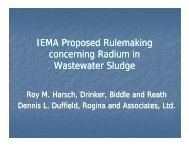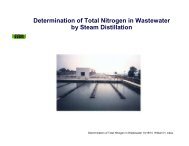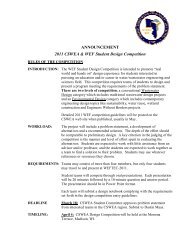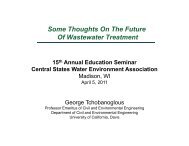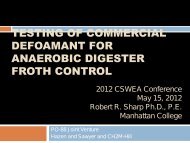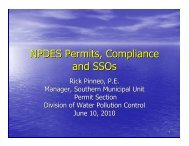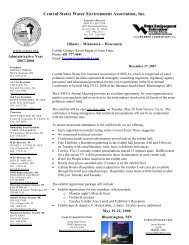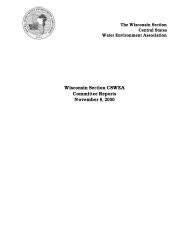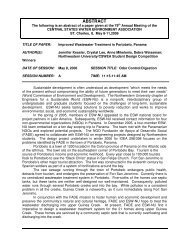August 15, 2001 Summer Board Meeting - Central States Water ...
August 15, 2001 Summer Board Meeting - Central States Water ...
August 15, 2001 Summer Board Meeting - Central States Water ...
You also want an ePaper? Increase the reach of your titles
YUMPU automatically turns print PDFs into web optimized ePapers that Google loves.
Other topics planned for tracking in the future are: TMDLs<br />
Reports were received from Dave Taylor, Paul Kent, and Chad Olson.<br />
Information on the Wisconsin Section Web Site<br />
Rusty Schroedel has worked with Scott Thompson regarding getting the Committee reports on<br />
the Web Site. A format has been tentatively selected and will be populated with data shortly.<br />
PCB Soil Criteria Update<br />
Draft criteria have been proposed for both human and ecological receptors. The human<br />
health receptor results in the most limiting criteria. As currently proposed, the soil<br />
criteria would be so low (0.1 to 0.3 parts per billion) that land application in Wisconsin<br />
would be severely impacted and/or eliminated as a biosolids management option. The<br />
current rulemaking schedule calls for the DNR to seek authorization from the Natural<br />
Resources <strong>Board</strong> at its October meeting to take the proposed rule to public hearings.<br />
Actual dates for the hearings need to be established, but DNR is currently looking at the<br />
December/January timeframe.<br />
Concerns regarding the derivation of the proposed criteria remain the same. From a<br />
technical standpoint, criteria derivation is driven by the use of very conservative<br />
exposure assumptions, coupled with a risk level of 10 -7 . While POTW representatives<br />
on the DNR Advisory Committee have highlighted these concerns, there has been little<br />
movement to address these issues.<br />
Wisconsin Section members participating on the PCB Soil Criteria Advisory Committee<br />
continue to advocate for the use of good science, reasonable exposure scenarios,<br />
selection of an appropriate risk level, and the appropriate use of risk management<br />
during the criteria development process. Absent significant changes, this rulemaking<br />
effort will have significant economic impacts to the regulated community. POTWs<br />
should continue to track the progress of this effort and be prepared to participate during<br />
the public hearings.<br />
National Nutrient Criteria<br />
EPA has developed recommended criteria for TP, TN, Chlorophyll a and turbidity.<br />
Notice of these criteria was published in the January 9, <strong>2001</strong> Federal Register. EPA<br />
established a 90-day public comment period for these recommended criteria-the public<br />
comment period was subsequently extended by 30 days and ended on May 9, <strong>2001</strong>.<br />
The criteria are intended as a starting point - <strong>States</strong> may either adopt these criteria or<br />
develop more precise numeric levels (based on sound science) on a site-specific or sub<br />
region-specific basis. <strong>States</strong> are expected to develop associated water quality<br />
standards by 2004. The nutrient documents can be found at the following website:<br />
http://www.epa.gov/waterscience/criteria/nutrient/ecoregions/factsheet.html<br />
The EPA recommended criteria are very restrictive and are based on 25 th percentile<br />
concentrations. For the ecoregion that encompasses most of Wisconsin, the TP, TN<br />
and Chlorophyll a values for rivers and streams are 0.03 mg/l, 0.54 mg/l and 3.5 ìg/l



